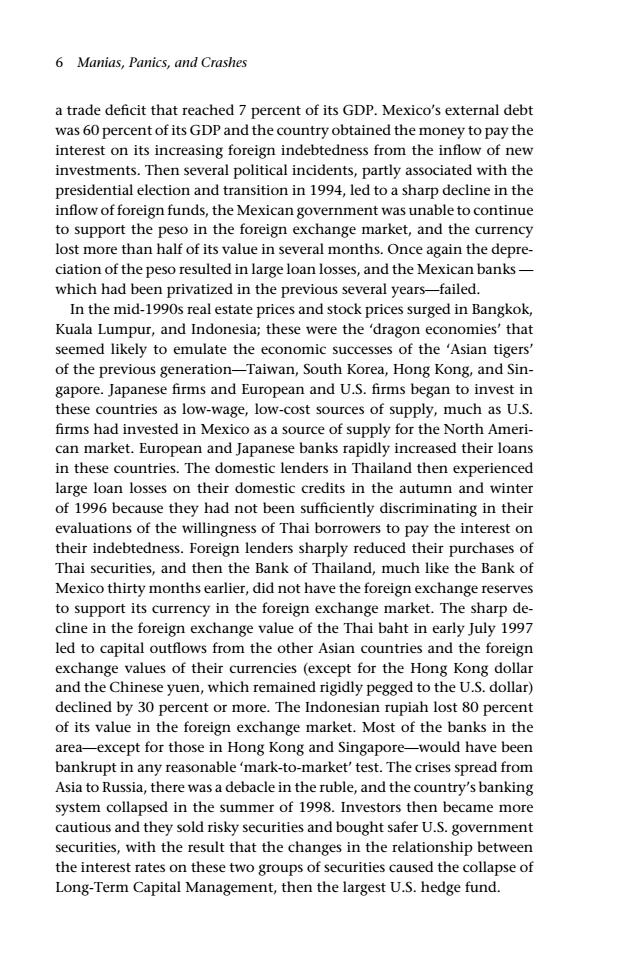正在加载图片...

6 Manias,Panics,and Crashes a trade deficit that reached 7 percent of its GDP.Mexico's external debt was 60 percent of its GDP and the country obtained the money to pay the interest on its increasing foreign indebtedness from the inflow of new investments.Then several political incidents,partly associated with the presidential election and transition in 1994,led to a sharp decline in the inflow of foreign funds,the Mexican government was unable to continue to support the peso in the foreign exchange market,and the currency lost more than half of its value in several months.Once again the depre- ciation of the peso resulted in large loan losses,and the Mexican banks- which had been privatized in the previous several years-failed. In the mid-1990s real estate prices and stock prices surged in Bangkok, Kuala Lumpur,and Indonesia;these were the 'dragon economies'that seemed likely to emulate the economic successes of the'Asian tigers' of the previous generation-Taiwan,South Korea,Hong Kong,and Sin- gapore.Japanese firms and European and U.S.firms began to invest in these countries as low-wage,low-cost sources of supply,much as U.S. firms had invested in mexico as a source of supply for the north ameri- can market.European and Japanese banks rapidly increased their loans in these countries.The domestic lenders in Thailand then experienced large loan losses on their domestic credits in the autumn and winter of 1996 because they had not been sufficiently discriminating in their evaluations of the willingness of Thai borrowers to pay the interest on their indebtedness.Foreign lenders sharply reduced their purchases of Thai securities,and then the Bank of Thailand,much like the Bank of Mexico thirty months earlier,did not have the foreign exchange reserves to support its currency in the foreign exchange market.The sharp de cline in the foreign exchange value of the Thai baht in early July 1997 led to capital outflows from the other Asian countries and the foreign exchange values of their currencies (except for the Hong Kong dollar and the Chinese yuen,which remained rigidly pegged to the U.S.dollar) declined by 30 percent or more.The Indonesian rupiah lost 80 percent of its value in the foreign exchange market.Most of the banks in the area-except for those in Hong Kong and Singapore-would have been bankrupt in any reasonable'mark-to-market'test.The crises spread from Asia to Russia,there was a debacle in the ruble,and the country's banking system collapsed in the summer of 1998.Investors then became more cautious and they sold risky securities and bought safer U.S.government securities,with the result that the changes in the relationship between the interest rates on these two groups of securities caused the collapse of Long-Term Capital Management,then the largest U.S.hedge fund. c01 JWBK120/Kindleberger February 13, 2008 14:58 Char Count= 6 Manias, Panics, and Crashes a trade deficit that reached 7 percent of its GDP. Mexico’s external debt was 60 percent of its GDP and the country obtained the money to pay the interest on its increasing foreign indebtedness from the inflow of new investments. Then several political incidents, partly associated with the presidential election and transition in 1994, led to a sharp decline in the inflow of foreign funds, the Mexican government was unable to continue to support the peso in the foreign exchange market, and the currency lost more than half of its value in several months. Once again the depreciation of the peso resulted in large loan losses, and the Mexican banks — which had been privatized in the previous several years—failed. In the mid-1990s real estate prices and stock prices surged in Bangkok, Kuala Lumpur, and Indonesia; these were the ‘dragon economies’ that seemed likely to emulate the economic successes of the ‘Asian tigers’ of the previous generation—Taiwan, South Korea, Hong Kong, and Singapore. Japanese firms and European and U.S. firms began to invest in these countries as low-wage, low-cost sources of supply, much as U.S. firms had invested in Mexico as a source of supply for the North American market. European and Japanese banks rapidly increased their loans in these countries. The domestic lenders in Thailand then experienced large loan losses on their domestic credits in the autumn and winter of 1996 because they had not been sufficiently discriminating in their evaluations of the willingness of Thai borrowers to pay the interest on their indebtedness. Foreign lenders sharply reduced their purchases of Thai securities, and then the Bank of Thailand, much like the Bank of Mexico thirty months earlier, did not have the foreign exchange reserves to support its currency in the foreign exchange market. The sharp decline in the foreign exchange value of the Thai baht in early July 1997 led to capital outflows from the other Asian countries and the foreign exchange values of their currencies (except for the Hong Kong dollar and the Chinese yuen, which remained rigidly pegged to the U.S. dollar) declined by 30 percent or more. The Indonesian rupiah lost 80 percent of its value in the foreign exchange market. Most of the banks in the area—except for those in Hong Kong and Singapore—would have been bankrupt in any reasonable ‘mark-to-market’ test. The crises spread from Asia to Russia, there was a debacle in the ruble, and the country’s banking system collapsed in the summer of 1998. Investors then became more cautious and they sold risky securities and bought safer U.S. government securities, with the result that the changes in the relationship between the interest rates on these two groups of securities caused the collapse of Long-Term Capital Management, then the largest U.S. hedge fund